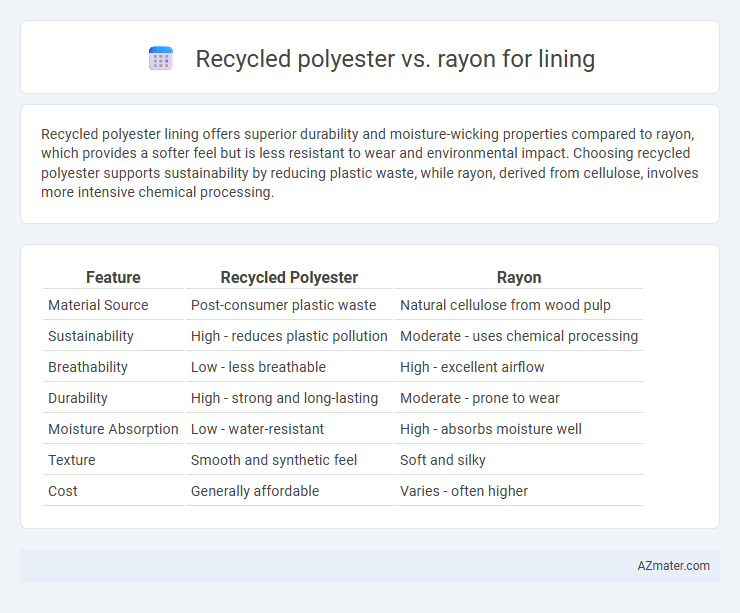Recycled polyester lining offers superior durability and moisture-wicking properties compared to rayon, which provides a softer feel but is less resistant to wear and environmental impact. Choosing recycled polyester supports sustainability by reducing plastic waste, while rayon, derived from cellulose, involves more intensive chemical processing.
Table of Comparison
| Feature | Recycled Polyester | Rayon |
|---|---|---|
| Material Source | Post-consumer plastic waste | Natural cellulose from wood pulp |
| Sustainability | High - reduces plastic pollution | Moderate - uses chemical processing |
| Breathability | Low - less breathable | High - excellent airflow |
| Durability | High - strong and long-lasting | Moderate - prone to wear |
| Moisture Absorption | Low - water-resistant | High - absorbs moisture well |
| Texture | Smooth and synthetic feel | Soft and silky |
| Cost | Generally affordable | Varies - often higher |
Introduction: The Importance of Lining Fabrics
Lining fabrics play a crucial role in garment construction by enhancing comfort, durability, and overall garment quality. Recycled polyester offers sustainability benefits with moisture-wicking properties and resistance to shrinking and stretching, making it ideal for eco-conscious fashion. Rayon, derived from natural cellulose fibers, provides a smooth, breathable texture and excellent drape, contributing to a luxurious feel while maintaining lightweight comfort.
What is Recycled Polyester?
Recycled polyester is a sustainable fabric made from reclaimed plastic materials, such as PET bottles, that are melted and spun into new fibers suitable for clothing linings. This eco-friendly alternative reduces reliance on virgin petroleum, decreases landfill waste, and consumes less energy during production compared to traditional polyester. Its durability, moisture-wicking properties, and resistance to wrinkles make recycled polyester a popular choice for lining fabrics in both fashion and upholstery.
Understanding Rayon: Origins and Properties
Rayon is a semi-synthetic fiber derived from natural cellulose sources such as wood pulp, known for its smooth texture, breathability, and excellent drape, making it a popular choice in lining fabrics. Unlike recycled polyester, which is produced from reprocessed plastic materials, rayon offers superior moisture absorption and a luxurious feel but tends to be less durable and more prone to shrinking and wrinkling. Understanding rayon's origin and properties highlights its natural origins and performance benefits, which influence its use in linings compared to the more eco-friendly and resilient recycled polyester alternatives.
Environmental Impact: Recycled Polyester vs Rayon
Recycled polyester, derived from post-consumer plastic waste, significantly reduces landfill and ocean pollution by reusing existing materials, whereas rayon production involves extensive deforestation and high water consumption, contributing to habitat loss. The chemical-intensive process of rayon manufacturing releases hazardous pollutants into waterways, posing a greater environmental threat compared to the relatively lower emissions of recycled polyester. Recycled polyester's energy-efficient production and ability to reduce reliance on virgin petroleum underscore its favorable environmental impact over rayon for lining applications.
Comfort and Wearability Comparison
Recycled polyester offers superior durability and moisture-wicking properties, making it ideal for activewear linings with excellent comfort and wearability. Rayon provides a natural, breathable feel with a soft texture, enhancing comfort but tends to be less resilient and more prone to shrinking or wrinkling. Choosing between recycled polyester and rayon depends on prioritizing long-lasting wear or a softer, more natural fabric feel for lining applications.
Durability and Maintenance
Recycled polyester lining exhibits superior durability due to its resistance to abrasion, wrinkles, and shrinking compared to rayon, which tends to wear out faster and is more prone to pilling. Maintenance of recycled polyester is easier as it can be machine washed and dries quickly, while rayon requires delicate care such as hand washing or dry cleaning to maintain its integrity. The strength and low-maintenance nature of recycled polyester make it a more practical choice for lining materials in garments subjected to frequent use.
Cost Differences and Availability
Recycled polyester typically costs less than rayon due to lower production expenses and thriving recycling programs, making it a budget-friendly choice for lining materials. Rayon, derived from natural cellulose fibers, often commands a higher price because of its more complex manufacturing process and fluctuating raw material costs. Availability of recycled polyester is generally more consistent globally, supported by growing sustainability initiatives, whereas rayon supply can be more variable due to regional production constraints and dependency on pulp sources.
Moisture Management and Breathability
Recycled polyester offers superior moisture-wicking properties, effectively drawing sweat away from the skin and promoting faster drying, making it ideal for activewear linings. Rayon, derived from natural cellulose fibers, provides excellent breathability and softness but tends to retain moisture longer, which may lead to discomfort in high-sweat conditions. Choosing recycled polyester lining enhances moisture management and durability, while rayon lining prioritizes comfort and breathability in low-exertion environments.
Best Uses for Each Fabric in Lining
Recycled polyester excels in lining applications requiring moisture-wicking, durability, and eco-friendly performance, making it ideal for activewear, outerwear, and bags. Rayon offers a smooth, breathable, and lightweight texture, preferred for high-end suits, dresses, and luxury garments where comfort and elegance are paramount. Choosing between recycled polyester and rayon depends on the need for sustainability and resilience versus softness and drape in lining fabric.
Which Lining Fabric Should You Choose?
Recycled polyester offers superior durability, moisture-wicking properties, and environmental benefits due to its production from post-consumer plastic waste, making it a sustainable choice for lining fabric. Rayon, while softer and more breathable, lacks the longevity and eco-friendly credentials of recycled polyester. Choosing between these fabrics depends on prioritizing sustainability and durability with recycled polyester or comfort and breathability with rayon for garment linings.

Infographic: Recycled polyester vs Rayon for Lining
 azmater.com
azmater.com